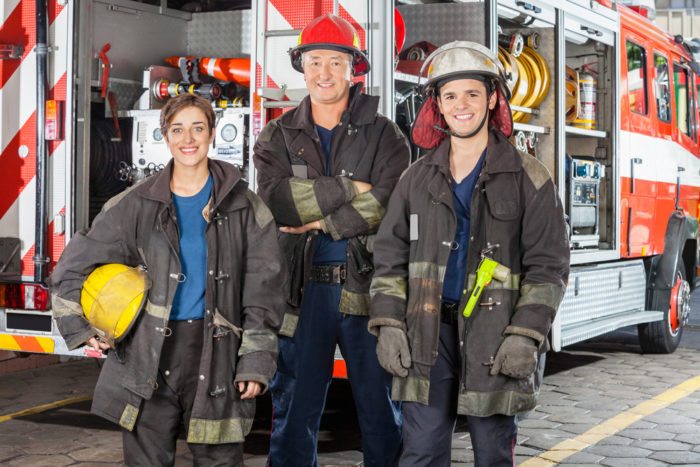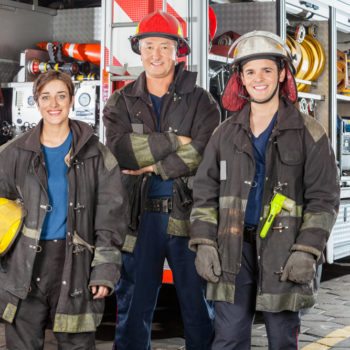Why We Love It
-
$49,330Potential Avg. Salary
-
5.3%Job Growth Rate
-
Growing DemandJob Outlook
-
Fast Paced CareerCareer Attribute
Firefighters are called in to handle emergencies. In some cases, the emergency is a fire that needs to be extinguished. In other cases, they’re called in to conduct emergency extractions for car wrecks, or to provide medical care. They use specialized tools to put out fires and rescue people when necessary.
Recommended Schools
What is a Firefighter?
The following job responsibilities are common for individuals in firefighter roles:
- Respond to calls for fires, car wrecks, and medical emergencies
- Prepare equipment quickly after a call, and drive fire trucks to the scene of an emergency
- Connect fire hoses to fire hydrants, and use water from the hydrant to put out fires
- Enter burning buildings to rescue trapped or unconscious individuals
- Use jaws of life and other tools to get people out of damaged cars after accidents
A Day in the Life
While firefighters are best known for their role of putting out fires, firefighters are called in to handle a variety of emergencies. In addition to responding to calls about fires, they’re also responders for car wrecks and other medical emergencies. Firefighters can provide basic medical care—much like a paramedic—and they also have specialized tools that can be used to extract individuals from damaged cars. They often use a tool called the jaws of life to open cars so that trapped individuals can escape.
And while firefighters can perform many responsibilities, their primary role is to respond to and handle fire emergencies. They receive calls for fires, quickly gear up and ready equipment, and drive fire trucks to the scene. Once there, they either troubleshoot non-obvious issues and threats, or they actively work to put out fires. They may employ fire extinguishers to extinguish fires, or they may connect fire hoses to fire hydrants. They may also have to enter burning buildings to rescue people who are trapped inside.
But it is not all thrills and excitement for firefighters 100% of the time. When there are no emergencies to respond to, firefighters spend a lot of time hanging out in the fire house, cleaning and repairing equipment, and waiting for calls. Often, they work 24-hour shifts, so they eat, drink, and sleep in the fire house. When an emergency is called in, they have only minutes to stop what they’re doing—or wake up if sleeping—and prepare themselves, their truck, and their equipment to respond to the call.
Typical Work Schedule
Often, firefighters work 24-hour shifts, two days a week. During those shifts, they eat, drink, and sleep in the fire house, but they must be prepared to respond at any moment to an emergency call. Other firefighters may work 10-hour shifts, four days a week. The working schedule for firefighters depends highly on individual employer preferences.
Firefighter Specializations
- Firefighters are general responders who receive and respond to calls for fires within a specific area, or medical emergencies/car accidents in that area.
- Wildland firefighters are specialists who focus on extinguishing or controlling fires on land masses caused by drought, other dry conditions, high winds, or neglect.
Typical Employers
Almost all firefighters are employed by local governments. Of those who aren’t, they commonly work for state or federal governments, or for airports, industrial plants, and other businesses that work with materials that are prone to catch on fire. Additionally, many firefighters provide services on a volunteer basis and may not be paid for their services.
Recommended Schools
How To Become a Firefighter
The basic requirements for becoming a firefighter are a high school diploma, being 18 years old, and having a driver’s license. Additionally, they must hold an emergency medical technician (EMT) certification. To become an EMT, you’ll need to complete up to two years of postsecondary education. Certification to work as an EMT is provided by the National Registry of Emergency Medical Technicians (NREMT) and requires candidates to pass an exam with written and practical components.
While all states require NREMT certification, each state has its own regulations on certification prerequisites. The number of hours of coursework required and degree/certificate requirements vary by state, so individuals will need to determine requirements for individual states prior to pursuing coursework. In some cases, earning an EMT certification will result in being awarded an associate’s degree. In other cases, EMT certification is the only credential received for this education.
After becoming certified as an EMT, you’ll have to pass a series of tests to qualify to work as a firefighter. You’ll need to pass written and physical examinations as well as background and drug screenings. If all of these tests are passed successfully, you’ll begin training at your local fire academy. There, you’ll learn how to fight fires, use specialized equipment, and identify potentially unsafe situations. You may also need to be trained on the job with your employer after fire academy.
Firefighter Salary Data
We’ve provided you the following to learn more about this career. The salary and growth data on this page comes from recently published Bureau of Labor Statistics data while the recommendations and editorial content are based on our research.
National Anual Salary
Low Range
$32,080Average
$49,330High Range
$79,490National Hourly Wage
Low Range
$15/hrAverage
$24/hrHigh Range
$38/hrHow do Firefighter salaries stack up to other jobs across the country? Based on the latest jobs data nationwide, Firefighter's can make an average annual salary of $49,330, or $24 per hour. This makes it an Above Average Salary. On the lower end, they can make $32,080 or $15 per hour, perhaps when just starting out or based on the state you live in.
Salary Rankings And Facts
#398 Nationally for All Careers
Programs and Degrees
Here are the most common degrees for becoming a Firefighter. a is usually recommended and specifically a degree or coursework that prepares you for the particular field, see below.
Highest Education Among Firefighters
- 0.2% Doctorate
- 1.8% Masters
- 17.3% Bachelors
- 20.1% Associates
- 43.5% College
- 16.1% High School
- 1% Less than High School
Job Growth Projections and Forecast
2014 Total Jobs
327,3002024 Est. Jobs
344,700Job Growth Rate
5.3%Est. New Jobs
17,400How does Firefighter job growth stack up to other jobs across the country? By 2024, there will be a change of 17,400 jobs for a total of 344,700 people employed in the career nationwide. This is a 5.3% change in growth over the next ten years, giving the career a growth rate nationwide of Below Average.
Growth Rankings And Facts
#413 Nationally for All Careers
What Companies Employ The Most Firefighters
| Industry | Current Jobs | New Jobs Needed | % Increase |
|---|---|---|---|
| Local government, excluding education and hospitals | 298,300 | 16,800 | 17% |
| Other support services | 11,200 | 900 | 1% |
| Federal government, excluding postal service | 8,100 | -800 | -1% |













